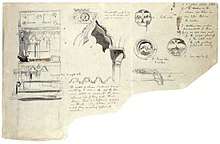The Stones of Venice (book)
.jpg) The Nature of Gothic in a Kelmscott Press edition. First page of text, with ornamented border. | |
| Author | John Ruskin |
|---|---|
| Country | United Kingdom |
| Language | English |
Publication date | 1851 - 1853 |
| Preceded by | The Seven Lamps of Architecture |
For the 2001 Doctor Who audio story, see The Stones of Venice (audio drama)
The Stones of Venice is a three-volume treatise on Venetian art and architecture by English art historian John Ruskin, first published from 1851 to 1853.
The Stones of Venice examines Venetian architecture in detail, describing for example over eighty churches. He discusses architecture of Venice's Byzantine, Gothic and Renaissance periods, and provides a general history of the city. As well as being an art historian, Ruskin was a social reformer. In the chapter "The Nature of Gothic" (from volume 2), Ruskin gives his views on how society should be organised.
We want one man to be always thinking, and another to be always working, and we call one a gentleman, and the other an operative; whereas the workman ought often to be thinking, and the thinker often to be working, and both should be gentlemen, in the best sense. As it is, we make both ungentle, the one envying, the other despising, his brother; and the mass of society is made up of morbid thinkers and miserable workers. Now it is only by labour that thought can be made healthy, and only by thought that labour can be made happy, and the two cannot be separated with impunity.[1]
Research and publication
Ruskin set out to prove how Venetian architecture exemplified the principles he discussed in his earlier work, The Seven Lamps of Architecture.[2] Ruskin had visited Venice before, but he made two visits to Venice with his wife Effie specially to research the book. The first visit was in the winter of 1849-50. The first volume of The Stones of Venice appeared in 1851 and Ruskin spent another winter in Venice researching the next two volumes. His research methods included sketching and photography (by 1849 he had acquired his own camera so that he could take daguerrotypes).[3]

Various shortened editions of the book have been published, including one edited by J.G. Links published in the USA in 1960.[4]
Publication history, first editions
- The Stones of Venice. Volume the First. The Foundations, 1851, Smith, Elder & Co., London
- The Stones of Venice. Volume the Second. The Sea-stories, 1853, Smith, Elder & Co., London
- The Stones of Venice. Volume the Third. The Fall, 1853, Smith, Elder & Co., London
Reception
It aroused considerable interest in Victorian Britain and beyond. The chapter "The Nature of Gothic" was admired by William Morris, who published it separately in an edition which is in itself an example of Gothic revival. The book inspired Marcel Proust (the narrator of the Recherche visits Venice with his mother in a state of enthusiasm for Ruskin) and in 2010 Roger Scruton wrote that the book was, "the greatest description in English of a place made sacred by buildings".[5]
See also
Notes
- ↑ Cook and Wedderburn 10.201.
- ↑ His introduction to the second edition (1855) characterises The Seven Lamps of Architecture not as a "complete exponent" of his matured views but "rather as an introduction to the more considered and careful statements of those views given in The Stones of Venice, and in my Lectures delivered at Edinburgh."
- ↑ Reynolds, Nigel (2006). "Mystery photographs". Daily Telegraph. Retrieved 4 September 2014.
- ↑ John Ruskin, The Stones of Venice, ed. by J.G. Links 1960. ISBN 978-0-306-81286-6.
- ↑ Scruton, Roger (November 2010). "The Wilderness Obsession". spectator.org. Retrieved 2012-08-02.
External links
- The Stones of Venice (Introductions) at Project Gutenberg
- Volume 1 at Archive.org
- Volume 2 at Archive.org
- Volume 3 at Archive.org
- John Ruskin The Stones of Venice St Mark's Literary discussion animation on YouTube